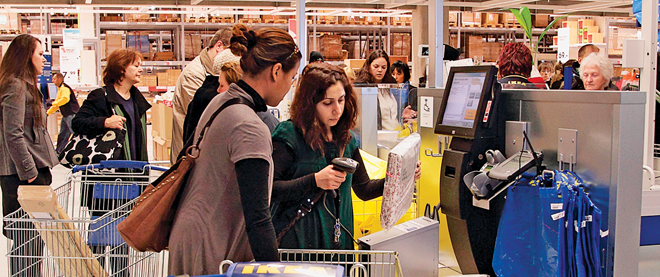The long and short of it
Eliminating cashier lineups has become the holy grail for retailers
Andreas Rentz/Getty Images
Share

When Richard Larson’s son turned five, the Massachusetts Institute of Technology professor decided it was time to get him a bike. One evening, the family drove to a Sears in Boston. Within a few minutes, Larson selected a red one, paid, and walked to the warehouse for pickup. Then Larson waited 40 minutes in a disorganized line for it to arrive. “This was supposed to be fast. I was so angry by the time the [bike] finally surfaced that I said, ‘That box will never be opened! I’m returning it,’ ” recalls Larson, 26 years later. “I’ve never been back to that specific store. And it took 10 years to go to any Sears.”
Despite advances in retail design and technology, no company has figured out how to eliminate the worst part of shopping: lineups. So stupefying is this fact that Larson has devoted his career to “queue theory,” or the science of waiting. (The bike fiasco prompted him to write a proposal for research funding, which he received.) “Speed is king. People don’t want to be delayed in anything they view as a chore or errand,” says Larson. And in today’s globalized market, where products are less and less differential across stores, the checkout experience is critical, he continues. In fact, in recent years lineups have become one of the most analyzed and controversial aspects of retail.
Since the late 1990s, retailers have been installing self-checkouts as a way of appeasing patrons who want more control over how long it takes to pay and get out. In 2008, there were 74,000 self-checkout units across North America, according to a Retail Banking Research report, and by 2014 that number should grow 20 per cent. But whether or not self-checkout actually improves wait times is contentious; it may just give that impression—a phenomenon known as “wait warping.” Consumers trade standing in a long line for taking a long time to put through their own items.
Tim Dickey, a technology blogger who also works at NCR Canada, which supplies checkout systems to retailers, says that self-checkout can actually enhance the shopping experience if cashiers are reassigned to the store floor. “There’s a lot of information to be gained from the staff, so it’s better to have them helping others than scanning items.” Still, Dickey acknowledges that self-checkout hasn’t solved the lineup conundrum: “It is polarizing. You either love it or you hate it.”
That explains the recent commotion that erupted over news that Albertsons, an American grocer, would be removing its self-checkouts. At the same time, Kroger, another supermarket chain in the States, is implementing more advanced self-checkouts that allow consumers to put their items on a conveyor that scans for them. And in Canada, Dickey says, some retailers have considered moving to self-checkout only, like at Fresh & Easy stores in the U.S.
While this debate over self-checkout rages, yet another lineup strategy is emerging: the “single serpentine line,” also known as the “metro” or “Euro-style” queue. Customers converge in one line and funnel down an aisle flanked by items toward several cashiers. “Instead of having three feet of spontaneous goods to buy, like trash magazines and gum, retailers have 40 feet,” says Larson. This technique is the fairest, too: “That line, because of the law of large numbers and probability, will move at a fairly constant pace,” he says. The trouble with the serpentine system, however, is optics: if it gets too long, it might deter customers from making a purchase.
There’s only one sure thing when it comes to waiting in line, says Larson. At worst, “it causes stress, anxiety and ‘queue rage.’ It feels unfair. And people will remember it for hours.” Or years.